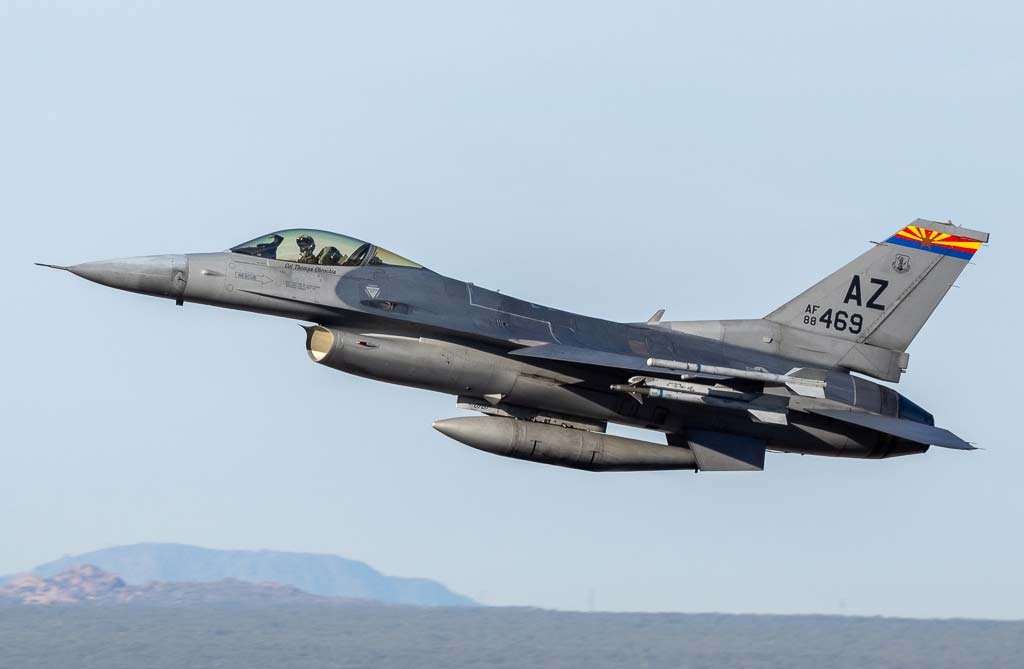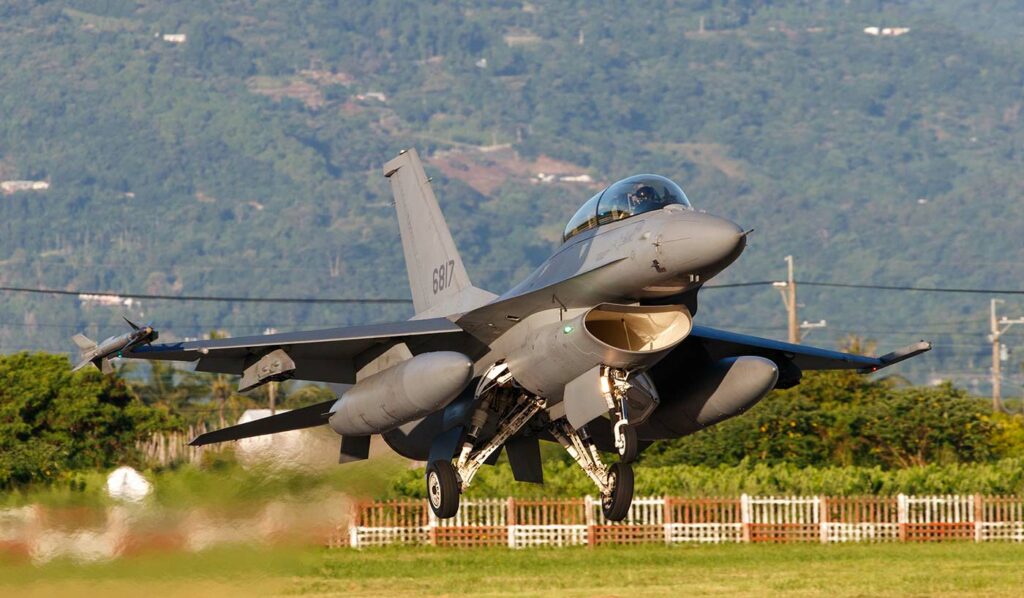Highly maneuverable, multirole fighter jet, essential for numerous air forces globally.
In brief
The Lockheed Martin F-16 Fighting Falcon is a multirole jet fighter developed in the United States, known for its agility and versatility across various mission profiles. This aircraft is powered by a single Pratt & Whitney F100-PW-200 or General Electric F110-GE-100 afterburning turbofan engine, depending on the variant, which delivers up to 29,000 pounds of thrust. Its top speed exceeds Mach 2, with a combat radius of over 500 miles and a service ceiling above 50,000 feet. The F-16 was designed to be small, lightweight, and inexpensive to build while incorporating fly-by-wire (FBW) technology, making it one of the first aircraft to achieve relaxed static stability for enhanced agility.

History of the Development of the Lockheed Martin F-16 Fighting Falcon
The Lockheed Martin F-16 Fighting Falcon, developed initially by General Dynamics, was born out of the requirements of the U.S. Air Force’s Lightweight Fighter (LWF) program initiated in 1972. This program aimed to develop a cost-effective, lightweight, and highly maneuverable aircraft to complement and supplement the larger and more expensive fighters like the F-15. The urgency for such a fighter stemmed from the experiences of the Vietnam War, which highlighted the need for an aircraft that could achieve air superiority and support ground operations effectively.
General Dynamics’ design was selected in a competitive trial against the Northrop YF-17, and the prototype, designated YF-16, first flew on January 20, 1974. By January 1975, the Air Force had ordered full-scale production of the F-16, marking the beginning of what would become one of the most successful fighter programs in history.
The aircraft did not receive a specific NATO nickname, which is typical for U.S. military aircraft that have become standard across various air forces worldwide. The F-16 was designed during a period marked by rapid technological advances in avionics and aerodynamics, reflecting a shift towards more versatile and capable yet cost-effective military assets.
Design of the Lockheed Martin F-16 Fighting Falcon
The F-16 features a lightweight airframe constructed primarily from aluminum alloys, with steel and titanium used in critical areas. It stands out for its frameless bubble canopy, which provides the pilot with exceptional visibility, and its side-mounted control stick to ease control while maneuvering under high g-forces. The aircraft’s design incorporates a 30-degree reclined seat to increase pilot comfort and resistance to g-forces during dogfights.
With an overall length of 15 meters and a wingspan of 9.45 meters, the F-16’s design focuses on reducing drag and enhancing agility in the air. Its avionics include a multifunction radar for all-weather, day and night operations, and advanced electronic warfare systems to enhance survivability in hostile environments. The integration of fly-by-wire (FBW) controls was revolutionary, replacing conventional manual flight controls with an electronic interface that improves performance and reduces pilot workload.
One of the major advantages of the F-16 is its versatility in carrying an array of weaponry and sensors, allowing for multirole capabilities in a single airframe. However, its small size and single-engine configuration can be seen as drawbacks, limiting its range and payload compared to larger twin-engine fighters.
Performance of the Lockheed Martin F-16 Fighting Falcon
The F-16’s performance is characterized by its Pratt & Whitney F100-PW-200 engine, providing up to 23,770 pounds of thrust, and in some models, the General Electric F110-GE-100, providing up to 29,000 pounds of thrust. This allows the jet to exceed speeds of Mach 2, with a maximum altitude of over 50,000 feet. It has a typical combat radius of 340 miles, extendable with aerial refueling.
Compared to contemporaries like the MiG-29 or the F/A-18, the F-16 maintains a competitive edge in terms of agility, cost of operation, and ease of maintenance. Its ability to serve in various roles from air-to-air combat to ground attack missions makes it a valuable asset for air forces worldwide.
Variants of the Lockheed Martin F-16 Fighting Falcon
The F-16 has been developed into numerous variants to suit the needs of different operators. The F-16A/B are the initial production variants, featuring the basic airframe and avionics. The F-16C/D introduced upgraded avionics, a bubble canopy, and an all-weather capability with the introduction of the Block 25, 30/32, 40/42, and 50/52 configurations, each improving on the avionics and engine enhancements. The F-16E/F, known as the Desert Falcon, features further improvements in avionics and weapon systems tailored for the United Arab Emirates.

Military Use and Combat of the Lockheed Martin F-16 Fighting Falcon
The F-16 Fighting Falcon, developed by Lockheed Martin, has been an integral part of the U.S. and allied air forces since its introduction. It has seen action in several major conflicts, demonstrating its versatility and effectiveness in a variety of combat roles. Here’s a detailed look at its participation in some key conflicts:
Persian Gulf War (1991)
During Operation Desert Storm, the F-16 played a crucial role in the coalition forces led by the United States against Iraq. It flew thousands of sorties, primarily focusing on air-to-ground attacks aimed at degrading Iraq’s military infrastructure and capabilities. The F-16s used a mix of conventional drop bombs and precision-guided munitions to target key installations, including airfields, military production facilities, and command and control centers. Its ability to perform both day and night missions made it a pivotal asset in achieving air superiority and disrupting Iraqi military logistics and communications.
Balkans Conflicts (1990s)
In the Balkans, the F-16 was again at the forefront of NATO operations, particularly during the enforcement of the no-fly zone over Bosnia and Herzegovina and later during the conflict in Kosovo. F-16s conducted air patrols to enforce the no-fly zone, preventing the use of aircraft in the ethnic cleansing operations. During Operation Deliberate Force and Operation Allied Force, they engaged in strike missions against strategic targets within the former Yugoslavia, using advanced munitions to minimize collateral damage while targeting Serbian military and infrastructure targets. Their missions included the suppression of enemy air defenses, which enabled safer operations for coalition aircraft.
Afghanistan (2001-present)
Since the beginning of Operation Enduring Freedom in Afghanistan, F-16s have been used extensively in ground support and counter-insurgency roles. They have provided close air support (CAS) for coalition ground forces, engaging Taliban and insurgent positions using both guided and unguided weapons. The flexibility of the F-16 allows it to respond quickly to calls for support from ground troops, delivering precision strikes to eliminate threats and support ground operations effectively.
Iraq (2003-2011, and ISIS operations from 2014)
During Operation Iraqi Freedom, F-16s were used to enforce no-fly zones over Iraq, and following the 2003 invasion, they supported ground operations against the Iraqi army. Throughout the prolonged presence in Iraq, they continued to perform a mix of strike missions, close air support, and reconnaissance missions, supporting various phases of combat operations, including urban combat scenarios in cities like Fallujah and Mosul. Later, F-16s were also used in operations against ISIS, performing strikes on key logistical and command centers to degrade the capabilities of ISIS and support local ground forces.
The deployment of F-16s in these conflicts highlights the aircraft’s adaptability to diverse combat scenarios, ranging from full-scale conventional warfare to asymmetrical combat and peace enforcement operations. The F-16’s advanced targeting systems, including laser and GPS-guided munitions, have enabled it to execute missions with high precision, which is crucial for compliance with modern rules of engagement that prioritize the minimization of collateral damage. This operational flexibility combined with ongoing upgrades to avionics, armaments, and performance enhancements ensures that the F-16 remains a valuable fighter asset capable of meeting contemporary combat challenges.
Its armament typically includes AIM-120 AMRAAM, AIM-9 Sidewinder missiles, and a variety of bombs and munitions. The aircraft’s design allows for a quick role change from air-to-air to air-to-ground missions, making it particularly effective in dynamic combat environments.
It has been deployed effectively for air superiority missions, ground attack, and electronic warfare. The versatility and reliability of the F-16 have led to its adoption by 25 nations, with over 4,500 units built. It remains in service in many countries, continually upgraded to meet modern combat requirements.
The F-16 Fighting Falcon represents a significant evolution in jet fighter design, successfully combining versatility, advanced technology, and cost-effectiveness. Its ongoing use and upgrades in numerous air forces worldwide attest to its fundamental design strengths and its continued relevance in modern air combat scenarios.
Back to the Fighter Jet section.